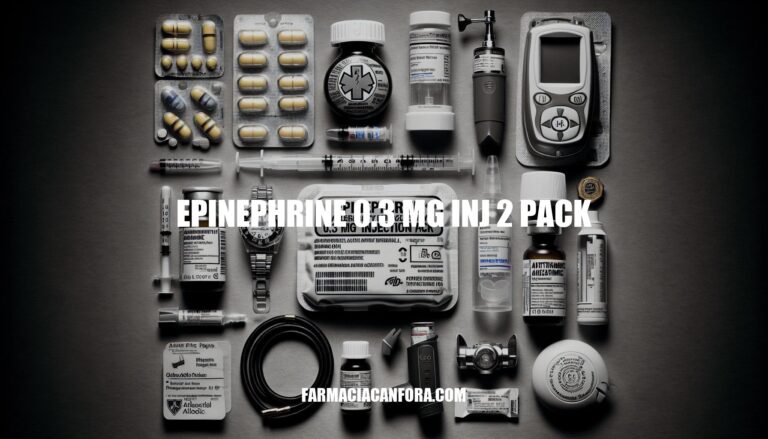Epinephrine 0.3 mg injection, often available in a convenient 2-pack, is a critical medication used in emergency medical situations to treat severe allergic reactions, known as anaphylaxis. This life-saving drug works quickly to improve breathing, stimulate the heart, and reduce swelling and hives, making it essential for individuals at risk of severe allergies.
Usage and Administration
Epinephrine 0.3 mg injection (2-pack) is used for emergency treatment of severe allergic reactions (anaphylaxis). Here’s how to use it:
- Identify the injector: Make sure you have the correct device. The EpiPen is commonly used.
- Remove the safety cap: Take off the blue safety cap to activate the injector.
- Position the injector: Hold the injector with the orange tip pointing downward. Place the orange tip against the outer thigh, at a right angle to the thigh. It can be injected through clothing if necessary.
- Administer the injection: Push the injector firmly into the thigh until it clicks. Hold it in place for about 3 seconds to ensure the full dose is delivered.
- Seek emergency help: Call emergency services immediately after using the injector. You may need further medical attention.
- Second dose if needed: If symptoms persist and emergency help has not arrived, a second injection may be administered after 5-15 minutes.
Always carry your epinephrine injector with you and inform family, friends, and caregivers on how to use it.
Mechanism of Action
Epinephrine, also known as adrenaline, is a hormone and neurotransmitter that acts on both alpha and beta adrenergic receptors. Here’s how it works to counteract severe allergic reactions:
-
Alpha Adrenergic Receptors: Epinephrine causes vasoconstriction (narrowing of blood vessels), which helps to reduce the vasodilation (widening of blood vessels) and increased vascular permeability that occur during anaphylaxis. This action helps to prevent the loss of intravascular fluid volume and counteracts hypotension (low blood pressure) .
-
Beta Adrenergic Receptors: Epinephrine relaxes the muscles in the airways, which helps to alleviate bronchospasm (tightening of the muscles around the airways) and improve breathing. It also increases heart rate and the force of cardiac contractions, which helps to maintain blood pressure and improve blood flow .
By acting on these receptors, epinephrine quickly reverses the severe symptoms of anaphylaxis, such as difficulty breathing, swelling, and low blood pressure, making it a critical emergency treatment.
Dosage and Packaging
Dosage and Packaging:
- Dosage: Each auto-injector delivers a single dose of 0.3 mg epinephrine.
- Packaging: The product comes in a pack of two auto-injectors.
Importance of Two Doses:
- Always carry two auto-injectors because a single dose may not be sufficient to treat a severe allergic reaction (anaphylaxis) before emergency medical help arrives.
Side Effects and Precautions
Potential Side Effects
- Common Side Effects: Anxiety, restlessness, tremor, dizziness, sweating, palpitations, pallor, nausea, vomiting, headache, and respiratory difficulties.
- Serious Side Effects: Fast/pounding heartbeat, trouble breathing, severe headache, and high blood pressure.
Necessary Precautions
- Usage: Inject into the outer thigh, through clothing if necessary. Avoid injecting into hands, feet, or buttocks.
- Post-Injection: Seek immediate medical help after use.
- Storage: Keep at room temperature, away from light and moisture.
Contraindications
- Medical Conditions: Heart disease, high blood pressure, asthma, Parkinson’s disease, thyroid disorders, and diabetes.
- Allergies: Inform your doctor if past use worsened an allergic reaction.
If you have any specific concerns or conditions, it’s always best to consult with your healthcare provider.
Storage and Handling
To ensure the effectiveness of ‘epinephrine 0.3 mg inj 2 pack’ in an emergency, follow these storage and handling guidelines:
- Temperature: Store at 20-25°C (68-77°F). Short-term excursions between 15-30°C (59-86°F) are permitted.
- Light Protection: Keep in the provided carrier tube to protect from light.
- Avoid Extreme Conditions: Do not refrigerate or expose to extreme heat or cold. Avoid storing in a vehicle’s glove box.
- Inspection: Regularly check the solution through the clear window for discoloration or particles. Replace if the solution turns pink or brown.
- Disposal: Dispose of used injectors in a puncture-proof “sharps” container and follow local disposal regulations.
By adhering to these guidelines, you can ensure that your epinephrine auto-injectors remain effective when needed.
Epinephrine 0.3 mg Injection: A Life-Saving Medication for Severe Allergic Reactions
Epinephrine 0.3 mg injection, also known as adrenaline, is a life-saving medication used to treat severe allergic reactions (anaphylaxis). It works quickly to improve breathing, stimulate the heart, and reduce swelling and hives.
Using an Epinephrine Auto-Injector
- Identify the injector
- Remove the safety cap
- Position the injector against the outer thigh
- Administer the injection
- Seek emergency help immediately
If symptoms persist, a second dose may be administered after 5-15 minutes. Always carry two auto-injectors and inform family, friends, and caregivers on how to use it.
How Epinephrine Works
Epinephrine works by acting on alpha and beta adrenergic receptors, causing vasoconstriction, relaxing airway muscles, increasing heart rate, and improving blood flow.
Potential Side Effects
- Anxiety
- Restlessness
- Tremor
- Dizziness
- Sweating
- Palpitations
- Pallor
- Nausea
- Vomiting
- Headache
- Respiratory difficulties
Storage and Handling Guidelines
To ensure effectiveness, store the auto-injectors at room temperature, away from light and moisture, and follow proper handling guidelines.


